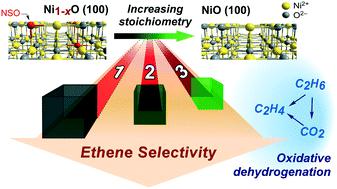当前位置:
X-MOL 学术
›
Catal. Sci. Technol.
›
论文详情
Our official English website, www.x-mol.net, welcomes your
feedback! (Note: you will need to create a separate account there.)
Tuning selectivity in nickel oxide-catalyzed oxidative dehydrogenation of ethane through control over non-stoichiometric oxygen density
Catalysis Science & Technology ( IF 4.4 ) Pub Date : 2020-11-11 , DOI: 10.1039/d0cy01732a Xiaohui Zhao 1, 2, 3, 4 , Mariano D. Susman 1, 2, 3, 4 , Jeffrey D. Rimer 1, 2, 3, 4 , Praveen Bollini 1, 2, 3, 4
Catalysis Science & Technology ( IF 4.4 ) Pub Date : 2020-11-11 , DOI: 10.1039/d0cy01732a Xiaohui Zhao 1, 2, 3, 4 , Mariano D. Susman 1, 2, 3, 4 , Jeffrey D. Rimer 1, 2, 3, 4 , Praveen Bollini 1, 2, 3, 4
Affiliation

|
Despite bulk metal oxide non-stoichiometry often being recognized as a key determinant of catalytic performance, clarifying its catalytic function has remained elusive due in part to the highly complex nature of many catalyst surfaces. In this study, we demonstrate that the non-stoichiometric oxygen (NSO) density for thermally stable nickel oxide cubes can be manipulated without measurable changes in degree of crystallinity, particle size, and morphology. UV-vis spectroscopy, temperature programmed desorption, and H2-temperature programmed reduction analyses all evidence monotonic decreases in NSO density upon thermal treatment; crucially, these decreases persist upon exposure to ethane and oxygen under oxidative dehydrogenation of ethane (ODHE) reaction conditions. Such control over NSO density under reaction conditions is used to tune ODHE ethene selectivity; independent of reaction conditions, at isoconversion, ethene selectivity tracks qualitatively with NSO density. These trends in selectivity, however, do not extend to conditions resulting in higher fractional hydroxyl coverages, for example, in the presence of water co-feeds, where primary ODHE selectivities vary only at the highest treatment temperature used in our study. Overall, this study points to (i) the need for well-defined oxide materials that enable (ideally) the exclusive variation of a single physicochemical property, (ii) the importance of using multiple characterization techniques for quantifying various properties, and (iii) the sensitivity of selectivity trends to surface coverages of reaction intermediates prevalent during their measurement. For the purpose of elucidating structure–catalytic property relationships, the approach reported herein involving the use of well-defined thermally stable faceted oxide crystals has the potential to be broadly applicable within the field of bulk oxide catalysis.
中文翻译:

通过控制非化学计量的氧气密度来调节乙烷在氧化镍催化的乙烷氧化脱氢中的选择性
尽管通常认为非金属化学计量的体金属氧化物是催化性能的关键决定因素,但部分由于许多催化剂表面的高度复杂性,弄清其催化功能仍然不清楚。在这项研究中,我们证明了可以对热稳定的氧化镍立方体的非化学计量氧(NSO)密度进行控制,而无需对结晶度,粒度和形态进行可测量的改变。紫外可见光谱,程序升温解吸和H 2程序升温还原分析了热处理后NSO密度单调下降的所有证据;至关重要的是,这些减少在乙烷的氧化脱氢(ODHE)反应条件下暴露于乙烷和氧气时仍然存在。在反应条件下对NSO密度的这种控制用于调整ODHE乙烯的选择性。与反应条件无关,在等转化率下,乙烯的选择性随NSO密度定性地变化。然而,选择性的这些趋势并未扩展到导致更高的羟基分数覆盖率的条件下,例如,在存在水共进料的情况下,其中主要的ODHE选择性仅在我们研究中使用的最高处理温度下才发生变化。总体,这项研究指出(i)需要定义明确的氧化物材料,以使(理想情况下)单一物理化学性质的排他性变化;(ii)使用多种表征技术量化各种性质的重要性,以及(iii)敏感性测量过程中普遍存在的反应中间体表面覆盖率的选择性趋势。为了阐明结构与催化性能之间的关系,本文报道的方法涉及使用定义明确的热稳定多面氧化物晶体,因此有可能在本体氧化物催化领域广泛应用。(iii)选择性趋势对在测量过程中普遍存在的反应中间体的表面覆盖的敏感性。为了阐明结构与催化性能之间的关系,本文报道的方法涉及使用定义明确的热稳定多面氧化物晶体,因此有可能在本体氧化物催化领域广泛应用。(iii)选择性趋势对在测量过程中普遍存在的反应中间体的表面覆盖的敏感性。为了阐明结构与催化性能之间的关系,本文报道的方法涉及使用定义明确的热稳定多面氧化物晶体,因此有可能在本体氧化物催化领域广泛应用。
更新日期:2020-11-21
中文翻译:

通过控制非化学计量的氧气密度来调节乙烷在氧化镍催化的乙烷氧化脱氢中的选择性
尽管通常认为非金属化学计量的体金属氧化物是催化性能的关键决定因素,但部分由于许多催化剂表面的高度复杂性,弄清其催化功能仍然不清楚。在这项研究中,我们证明了可以对热稳定的氧化镍立方体的非化学计量氧(NSO)密度进行控制,而无需对结晶度,粒度和形态进行可测量的改变。紫外可见光谱,程序升温解吸和H 2程序升温还原分析了热处理后NSO密度单调下降的所有证据;至关重要的是,这些减少在乙烷的氧化脱氢(ODHE)反应条件下暴露于乙烷和氧气时仍然存在。在反应条件下对NSO密度的这种控制用于调整ODHE乙烯的选择性。与反应条件无关,在等转化率下,乙烯的选择性随NSO密度定性地变化。然而,选择性的这些趋势并未扩展到导致更高的羟基分数覆盖率的条件下,例如,在存在水共进料的情况下,其中主要的ODHE选择性仅在我们研究中使用的最高处理温度下才发生变化。总体,这项研究指出(i)需要定义明确的氧化物材料,以使(理想情况下)单一物理化学性质的排他性变化;(ii)使用多种表征技术量化各种性质的重要性,以及(iii)敏感性测量过程中普遍存在的反应中间体表面覆盖率的选择性趋势。为了阐明结构与催化性能之间的关系,本文报道的方法涉及使用定义明确的热稳定多面氧化物晶体,因此有可能在本体氧化物催化领域广泛应用。(iii)选择性趋势对在测量过程中普遍存在的反应中间体的表面覆盖的敏感性。为了阐明结构与催化性能之间的关系,本文报道的方法涉及使用定义明确的热稳定多面氧化物晶体,因此有可能在本体氧化物催化领域广泛应用。(iii)选择性趋势对在测量过程中普遍存在的反应中间体的表面覆盖的敏感性。为了阐明结构与催化性能之间的关系,本文报道的方法涉及使用定义明确的热稳定多面氧化物晶体,因此有可能在本体氧化物催化领域广泛应用。











































 京公网安备 11010802027423号
京公网安备 11010802027423号